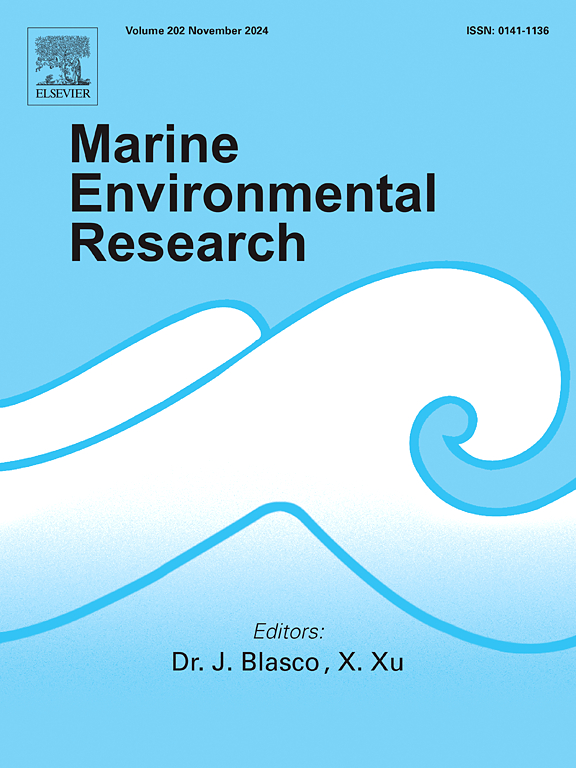In vitro negative effects of beach-cast invasive marine seaweed Rugulopteryx okamurae across life-stages of a native foundational species
IF 3
3区 环境科学与生态学
Q2 ENVIRONMENTAL SCIENCES
引用次数: 0
Abstract
The exotic invasive seaweed Rugulopteryx okamurae (Dictyotales, Ochrophyta) have posed a serious threat to coastal and marine habitats since its appearance in 2015 in the Strait of Gibraltar. This, together with multiple global change stressors, is leading to the disappearance of native foundational seaweeds. Here we explored the potential impacts that decomposing thalli of beach-cast R. okamurae (BCRo) might have on different life-stages of a native foundational seaweed (Ericaria selaginoides, Fucales, Ochrophyta). The in vitro effects of different biomass densities of BCRo and time exposure, in combination with three warming scenarios, were assessed across single- and few-celled stages and adult thalli of the native species. We hypothesized that R. okamurae might interfere in the survival and growth of E. selaginoides either by allelopathic interactions or water acidification, due to low intracellular pH of R. okamurae tissues. Sensitivity of E. selaginoides to the exposure of BCRo was stage- and thermal-dependent and decreased during early ontogenesis. Unfertilized oospheres (female gametes) exposed to BCRo experienced apoptotic-like cell death within less than 180 s, while embryo survival and germination dropped by 50 % and 36 %, respectively. Warming effects were not additive to that of BCRo, since higher growth reductions in 7-d old juveniles of E. selaginoides were detected at lower (20 °C) but not at higher temperatures (28 °C). Adults of E. selaginoides were the less sensitive stage but their growth was up to 7-times lower under BCRo addition. BCRo acidified natural sea water proportionally to the density and incubation time, reaching a pH of 7.2 after 24 h. However, that pH was not limiting for E. selaginoides juveniles and even enhanced their growth, suggesting an alternative chemical effect. This study highlighted the potential and overlooked deleterious effects that some species of beach-cast seaweeds can exert on the highly sensitive early developmental stages of native marine biota.

海滩投放的入侵海洋海藻 Rugulopteryx okamurae 对本地基础物种各生命阶段的体外负面影响
自2015年在直布罗陀海峡出现以来,外来入侵海藻Rugulopteryx okamurae (Dictyotales, Ochrophyta)对沿海和海洋栖息地构成了严重威胁。这与多种全球变化压力因素一起,正在导致原生基础海藻的消失。本研究探讨了滩投R. okamurae (BCRo)菌体分解对原生基础海藻(Ericaria selaginoides, Fucales, Ochrophyta)不同生命阶段的潜在影响。在三种变暖情景下,对不同BCRo生物量密度和暴露时间对本地种单细胞期、少细胞期和成体的体外效应进行了评估。我们推测,冈村田径菌可能通过化感作用或水体酸化作用干扰卷卷草的生存和生长,这可能是由于冈村田径菌组织的细胞内pH值较低。selaginoides对BCRo暴露的敏感性是阶段和热依赖的,并且在早期个体发生时降低。暴露于BCRo的未受精卵球(雌性配子)在不到180 s内发生凋亡样细胞死亡,胚胎存活率和萌发率分别下降50%和36%。增温效应与BCRo的增温效应无关,因为在较低(20°C)的温度下,7 d龄卷卷木幼鱼的生长下降幅度较大,而在较高(28°C)的温度下则没有。在BCRo的作用下,卷柏成虫的生长速度降低了7倍。BCRo对天然海水的酸化作用与浓度和孵育时间成正比,24 h后pH值达到7.2,但该pH值并不限制卷卷子幼鱼的生长,甚至可以促进卷卷子幼鱼的生长,表明存在替代化学效应。这项研究强调了一些海滩上的海藻对原生海洋生物高度敏感的早期发育阶段可能产生的潜在和被忽视的有害影响。
本文章由计算机程序翻译,如有差异,请以英文原文为准。
求助全文
约1分钟内获得全文
求助全文
来源期刊

Marine environmental research
环境科学-毒理学
CiteScore
5.90
自引率
3.00%
发文量
217
审稿时长
46 days
期刊介绍:
Marine Environmental Research publishes original research papers on chemical, physical, and biological interactions in the oceans and coastal waters. The journal serves as a forum for new information on biology, chemistry, and toxicology and syntheses that advance understanding of marine environmental processes.
Submission of multidisciplinary studies is encouraged. Studies that utilize experimental approaches to clarify the roles of anthropogenic and natural causes of changes in marine ecosystems are especially welcome, as are those studies that represent new developments of a theoretical or conceptual aspect of marine science. All papers published in this journal are reviewed by qualified peers prior to acceptance and publication. Examples of topics considered to be appropriate for the journal include, but are not limited to, the following:
– The extent, persistence, and consequences of change and the recovery from such change in natural marine systems
– The biochemical, physiological, and ecological consequences of contaminants to marine organisms and ecosystems
– The biogeochemistry of naturally occurring and anthropogenic substances
– Models that describe and predict the above processes
– Monitoring studies, to the extent that their results provide new information on functional processes
– Methodological papers describing improved quantitative techniques for the marine sciences.
 求助内容:
求助内容: 应助结果提醒方式:
应助结果提醒方式:


